The Cyber Security Issue of Hacking - Desklib
VerifiedAdded on 2023/06/12
|6
|1256
|335
AI Summary
This literature review focuses on the cyber security issue of hacking. It reviews a journal article about identity theft and cyber crime, and discusses the strengths and shortcomings of the article. The review concludes that hacking is a malevolent drawback of the cyberworld that should be penalized, and strategies should be implemented to prevent it.
Contribute Materials
Your contribution can guide someone’s learning journey. Share your
documents today.
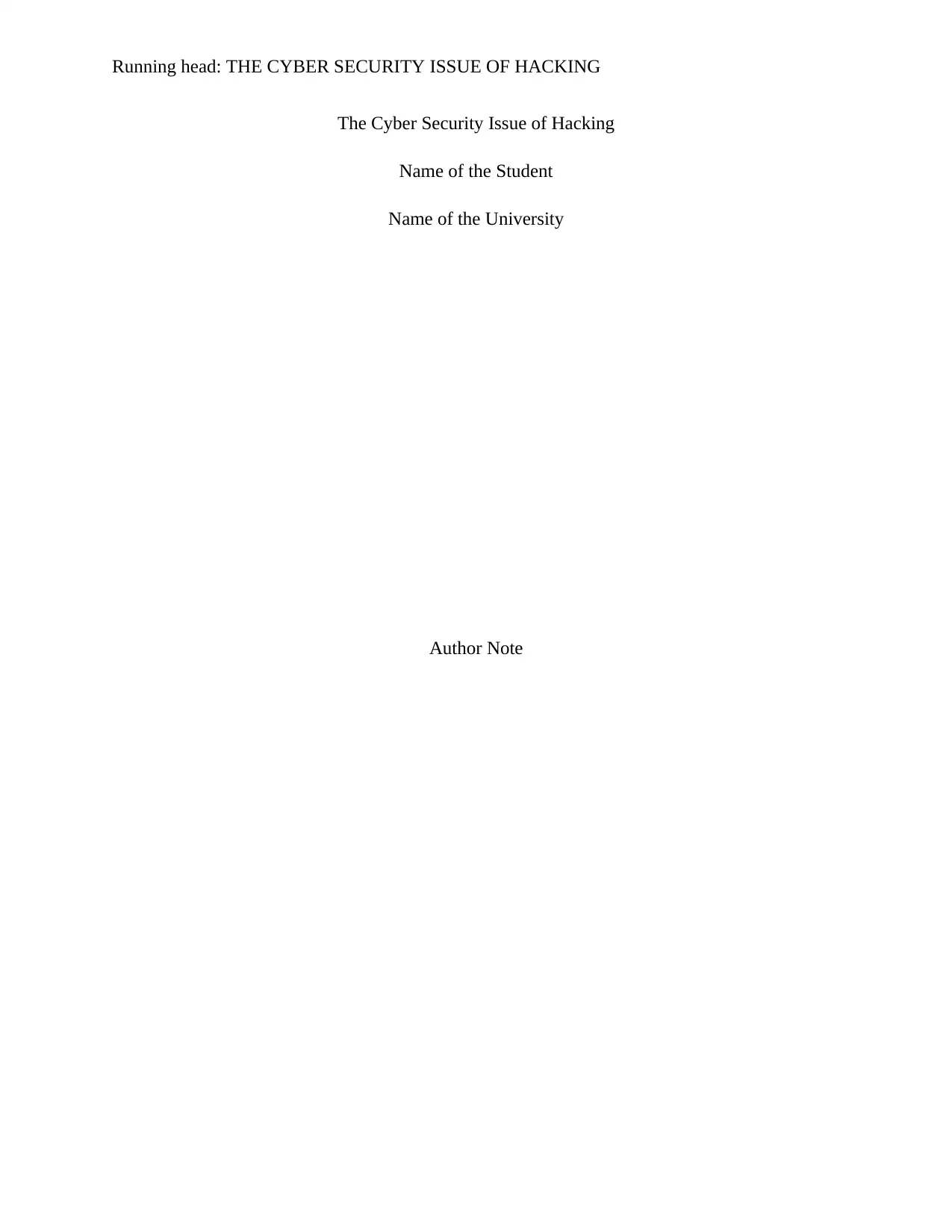
Running head: THE CYBER SECURITY ISSUE OF HACKING
The Cyber Security Issue of Hacking
Name of the Student
Name of the University
Author Note
The Cyber Security Issue of Hacking
Name of the Student
Name of the University
Author Note
Secure Best Marks with AI Grader
Need help grading? Try our AI Grader for instant feedback on your assignments.
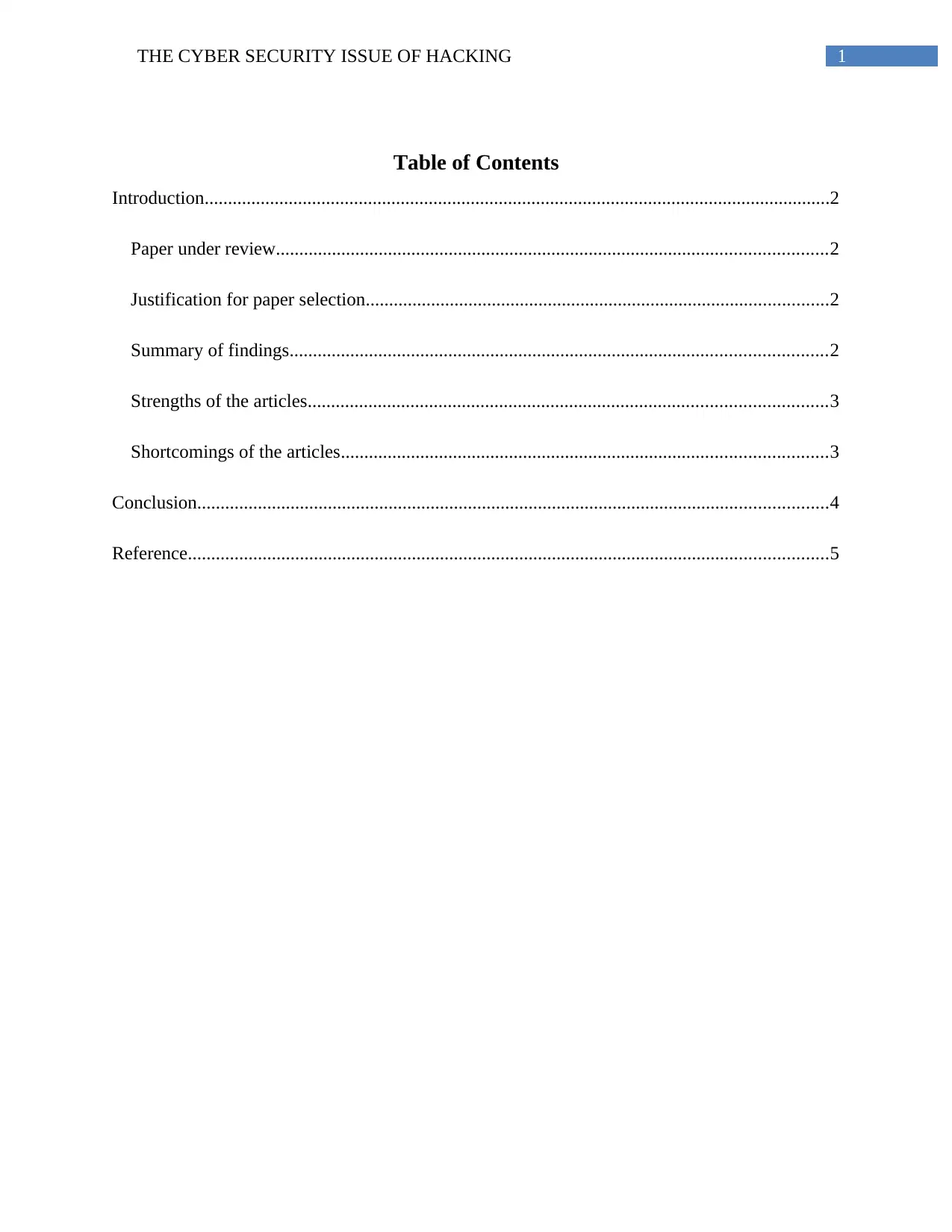
1THE CYBER SECURITY ISSUE OF HACKING
Table of Contents
Introduction......................................................................................................................................2
Paper under review......................................................................................................................2
Justification for paper selection...................................................................................................2
Summary of findings...................................................................................................................2
Strengths of the articles...............................................................................................................3
Shortcomings of the articles........................................................................................................3
Conclusion.......................................................................................................................................4
Reference.........................................................................................................................................5
Table of Contents
Introduction......................................................................................................................................2
Paper under review......................................................................................................................2
Justification for paper selection...................................................................................................2
Summary of findings...................................................................................................................2
Strengths of the articles...............................................................................................................3
Shortcomings of the articles........................................................................................................3
Conclusion.......................................................................................................................................4
Reference.........................................................................................................................................5
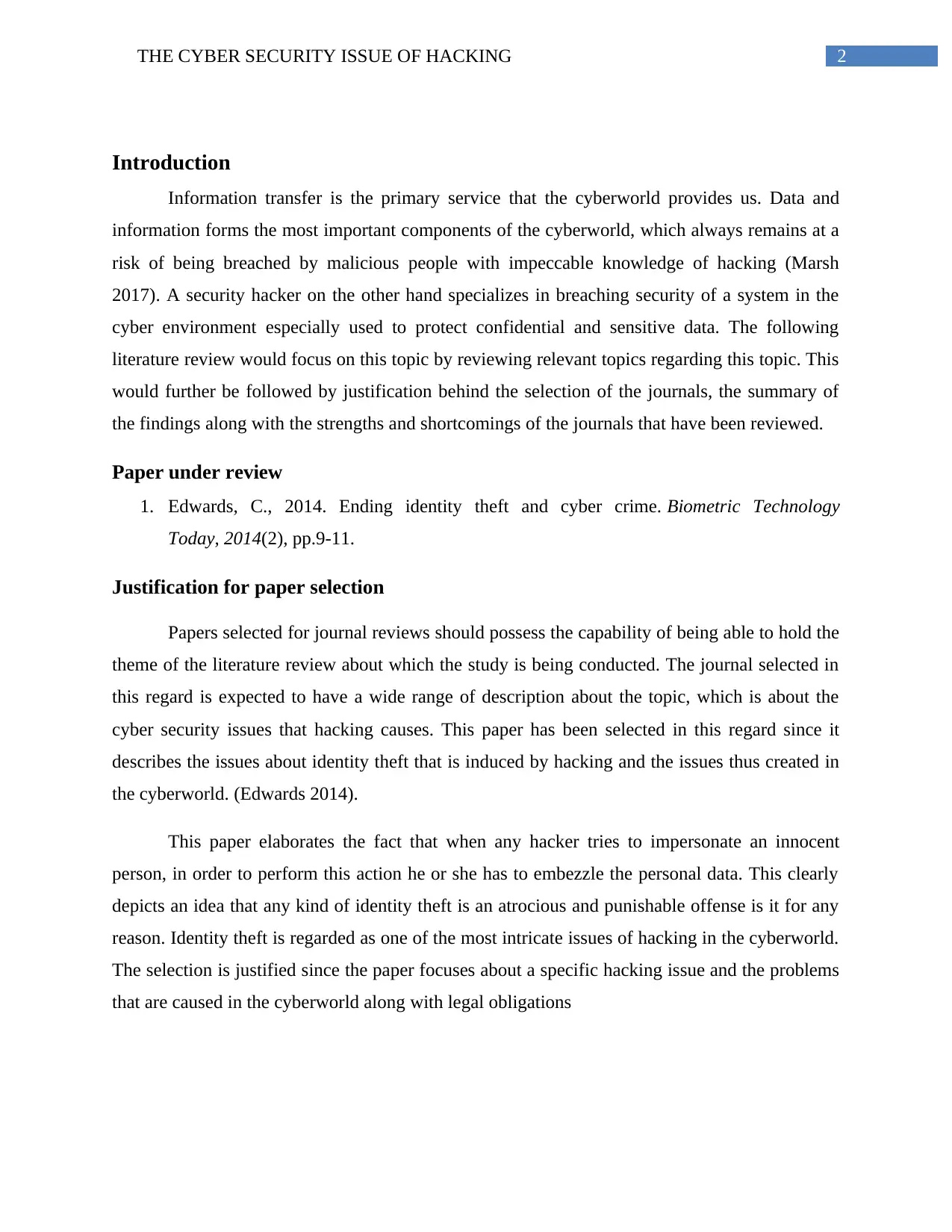
2THE CYBER SECURITY ISSUE OF HACKING
Introduction
Information transfer is the primary service that the cyberworld provides us. Data and
information forms the most important components of the cyberworld, which always remains at a
risk of being breached by malicious people with impeccable knowledge of hacking (Marsh
2017). A security hacker on the other hand specializes in breaching security of a system in the
cyber environment especially used to protect confidential and sensitive data. The following
literature review would focus on this topic by reviewing relevant topics regarding this topic. This
would further be followed by justification behind the selection of the journals, the summary of
the findings along with the strengths and shortcomings of the journals that have been reviewed.
Paper under review
1. Edwards, C., 2014. Ending identity theft and cyber crime. Biometric Technology
Today, 2014(2), pp.9-11.
Justification for paper selection
Papers selected for journal reviews should possess the capability of being able to hold the
theme of the literature review about which the study is being conducted. The journal selected in
this regard is expected to have a wide range of description about the topic, which is about the
cyber security issues that hacking causes. This paper has been selected in this regard since it
describes the issues about identity theft that is induced by hacking and the issues thus created in
the cyberworld. (Edwards 2014).
This paper elaborates the fact that when any hacker tries to impersonate an innocent
person, in order to perform this action he or she has to embezzle the personal data. This clearly
depicts an idea that any kind of identity theft is an atrocious and punishable offense is it for any
reason. Identity theft is regarded as one of the most intricate issues of hacking in the cyberworld.
The selection is justified since the paper focuses about a specific hacking issue and the problems
that are caused in the cyberworld along with legal obligations
Introduction
Information transfer is the primary service that the cyberworld provides us. Data and
information forms the most important components of the cyberworld, which always remains at a
risk of being breached by malicious people with impeccable knowledge of hacking (Marsh
2017). A security hacker on the other hand specializes in breaching security of a system in the
cyber environment especially used to protect confidential and sensitive data. The following
literature review would focus on this topic by reviewing relevant topics regarding this topic. This
would further be followed by justification behind the selection of the journals, the summary of
the findings along with the strengths and shortcomings of the journals that have been reviewed.
Paper under review
1. Edwards, C., 2014. Ending identity theft and cyber crime. Biometric Technology
Today, 2014(2), pp.9-11.
Justification for paper selection
Papers selected for journal reviews should possess the capability of being able to hold the
theme of the literature review about which the study is being conducted. The journal selected in
this regard is expected to have a wide range of description about the topic, which is about the
cyber security issues that hacking causes. This paper has been selected in this regard since it
describes the issues about identity theft that is induced by hacking and the issues thus created in
the cyberworld. (Edwards 2014).
This paper elaborates the fact that when any hacker tries to impersonate an innocent
person, in order to perform this action he or she has to embezzle the personal data. This clearly
depicts an idea that any kind of identity theft is an atrocious and punishable offense is it for any
reason. Identity theft is regarded as one of the most intricate issues of hacking in the cyberworld.
The selection is justified since the paper focuses about a specific hacking issue and the problems
that are caused in the cyberworld along with legal obligations

3THE CYBER SECURITY ISSUE OF HACKING
Summary of findings
The paper under review possesses information about the cybercrimes that have been in
vogue since the inception of the cyberworld. The findings lead to the learning outcomes about
the cyber security threats, the issues that can be regarded as cybercrime, the history about
hacking and the affects of hacking that impact upon the common people and cyberworld.
In the journal Edwards (2014) states the issues that are regarded as hacking. This state
that unable to authorize is also regarded as cybercrime and is a punishable offence. This is
mainly done by the malicious hackers to steal the online identity of a person and posing as
someone else to hide the malicious acts that one commits. In this journal, hacking has been
regarded as one of the main drawbacks that internet has as a byproduct. Electronification of the
world has eased up communication and has solved many other issues, however; it has also
imposed data vulnerability to malevolent users having desperate attempts to commit
cybercrimes. It is also mentioned in this paper that until this problem finds a proper solution
regarding proper authentication of a person and the prevention of stealing online identities, the
issues would persist and become much worse in the coming times.
Strengths of the articles
The strength of the article is that it focuses on every aspect of a hacking generated with
identity theft, also describing the facts about the proliferation of the cybercrimes and the first war
that was induced due to the identity hackings that took place in Iran by 2010 in Bushehr Nuclear
Plant (Singh 2015). The paper also suggests the solution about how these hackings could be
prevented as identity theft is dangerous and may even impose innocent people of crimes that they
have not committed (Van Wilsem 2011).
Shortcomings of the articles
The shortcoming of the first article is that it never clarifies the proper structure of a
journal recommending a collective solution for the problems (Cerrudo 2015). However, it
suggests eliminating third-party authentication entirely, discarding digital evidence preservation
(Clarke and Knake 2014). A concluding accumulation of all the information could not be found
in this journal article that would generate a wholesome idea on having a proper ending to the
Summary of findings
The paper under review possesses information about the cybercrimes that have been in
vogue since the inception of the cyberworld. The findings lead to the learning outcomes about
the cyber security threats, the issues that can be regarded as cybercrime, the history about
hacking and the affects of hacking that impact upon the common people and cyberworld.
In the journal Edwards (2014) states the issues that are regarded as hacking. This state
that unable to authorize is also regarded as cybercrime and is a punishable offence. This is
mainly done by the malicious hackers to steal the online identity of a person and posing as
someone else to hide the malicious acts that one commits. In this journal, hacking has been
regarded as one of the main drawbacks that internet has as a byproduct. Electronification of the
world has eased up communication and has solved many other issues, however; it has also
imposed data vulnerability to malevolent users having desperate attempts to commit
cybercrimes. It is also mentioned in this paper that until this problem finds a proper solution
regarding proper authentication of a person and the prevention of stealing online identities, the
issues would persist and become much worse in the coming times.
Strengths of the articles
The strength of the article is that it focuses on every aspect of a hacking generated with
identity theft, also describing the facts about the proliferation of the cybercrimes and the first war
that was induced due to the identity hackings that took place in Iran by 2010 in Bushehr Nuclear
Plant (Singh 2015). The paper also suggests the solution about how these hackings could be
prevented as identity theft is dangerous and may even impose innocent people of crimes that they
have not committed (Van Wilsem 2011).
Shortcomings of the articles
The shortcoming of the first article is that it never clarifies the proper structure of a
journal recommending a collective solution for the problems (Cerrudo 2015). However, it
suggests eliminating third-party authentication entirely, discarding digital evidence preservation
(Clarke and Knake 2014). A concluding accumulation of all the information could not be found
in this journal article that would generate a wholesome idea on having a proper ending to the
Secure Best Marks with AI Grader
Need help grading? Try our AI Grader for instant feedback on your assignments.
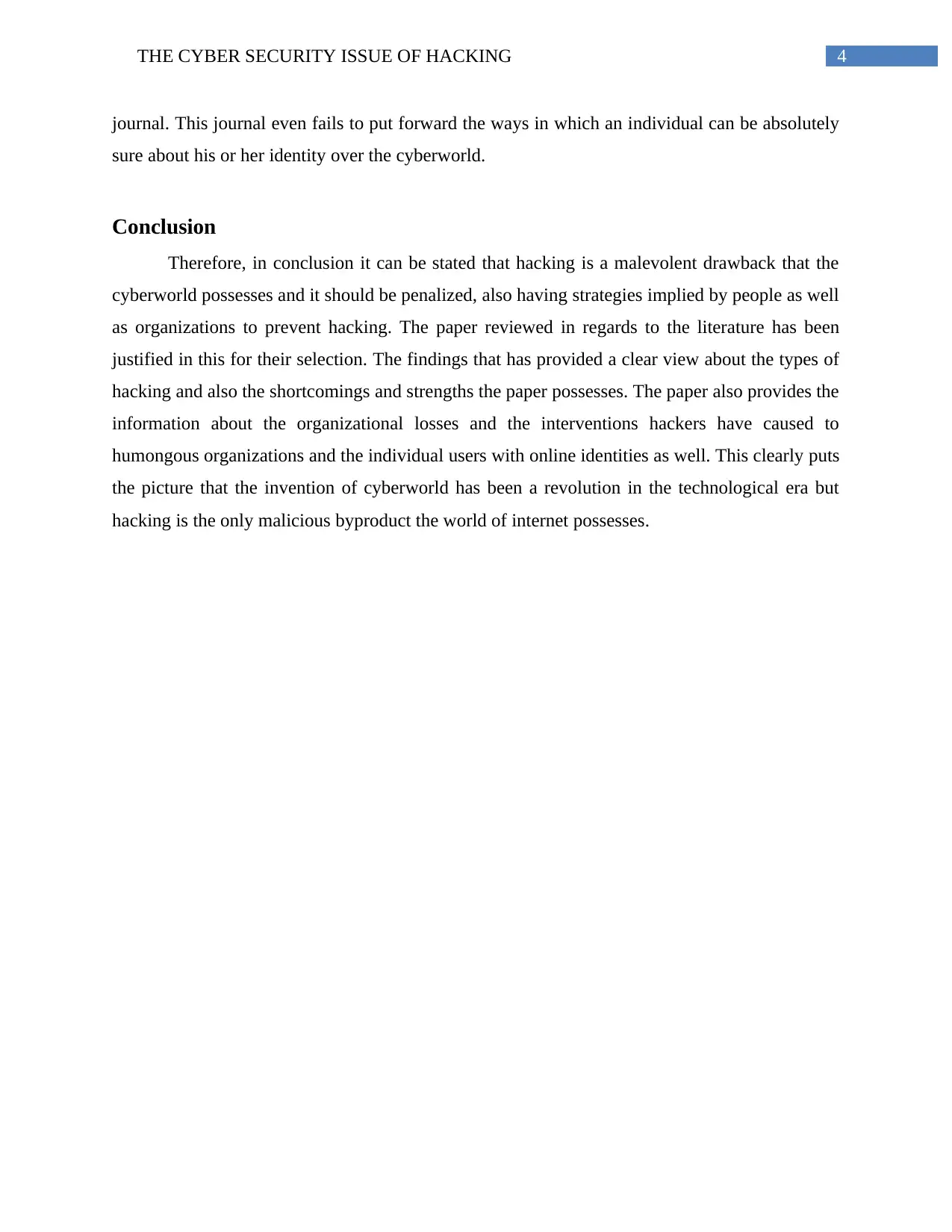
4THE CYBER SECURITY ISSUE OF HACKING
journal. This journal even fails to put forward the ways in which an individual can be absolutely
sure about his or her identity over the cyberworld.
Conclusion
Therefore, in conclusion it can be stated that hacking is a malevolent drawback that the
cyberworld possesses and it should be penalized, also having strategies implied by people as well
as organizations to prevent hacking. The paper reviewed in regards to the literature has been
justified in this for their selection. The findings that has provided a clear view about the types of
hacking and also the shortcomings and strengths the paper possesses. The paper also provides the
information about the organizational losses and the interventions hackers have caused to
humongous organizations and the individual users with online identities as well. This clearly puts
the picture that the invention of cyberworld has been a revolution in the technological era but
hacking is the only malicious byproduct the world of internet possesses.
journal. This journal even fails to put forward the ways in which an individual can be absolutely
sure about his or her identity over the cyberworld.
Conclusion
Therefore, in conclusion it can be stated that hacking is a malevolent drawback that the
cyberworld possesses and it should be penalized, also having strategies implied by people as well
as organizations to prevent hacking. The paper reviewed in regards to the literature has been
justified in this for their selection. The findings that has provided a clear view about the types of
hacking and also the shortcomings and strengths the paper possesses. The paper also provides the
information about the organizational losses and the interventions hackers have caused to
humongous organizations and the individual users with online identities as well. This clearly puts
the picture that the invention of cyberworld has been a revolution in the technological era but
hacking is the only malicious byproduct the world of internet possesses.
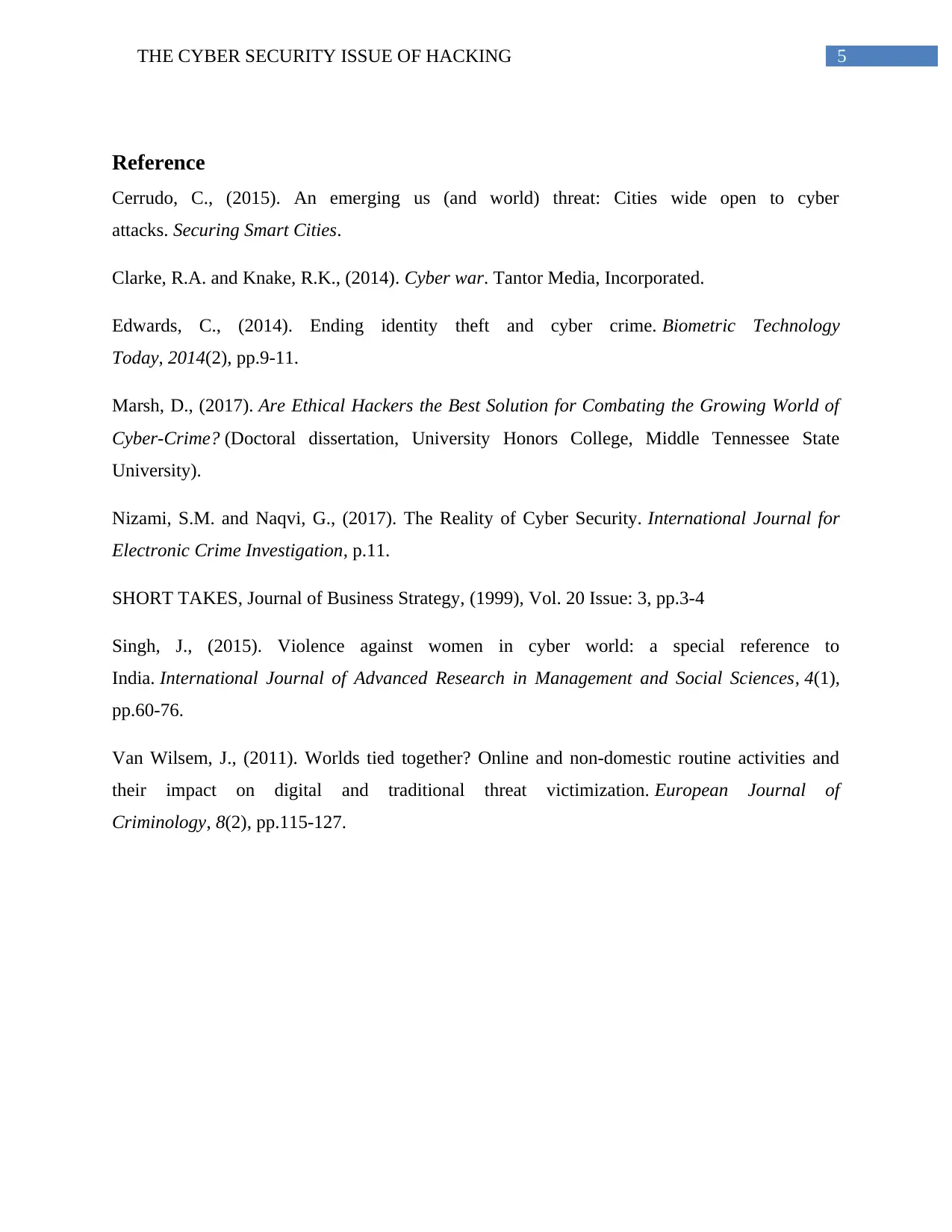
5THE CYBER SECURITY ISSUE OF HACKING
Reference
Cerrudo, C., (2015). An emerging us (and world) threat: Cities wide open to cyber
attacks. Securing Smart Cities.
Clarke, R.A. and Knake, R.K., (2014). Cyber war. Tantor Media, Incorporated.
Edwards, C., (2014). Ending identity theft and cyber crime. Biometric Technology
Today, 2014(2), pp.9-11.
Marsh, D., (2017). Are Ethical Hackers the Best Solution for Combating the Growing World of
Cyber-Crime? (Doctoral dissertation, University Honors College, Middle Tennessee State
University).
Nizami, S.M. and Naqvi, G., (2017). The Reality of Cyber Security. International Journal for
Electronic Crime Investigation, p.11.
SHORT TAKES, Journal of Business Strategy, (1999), Vol. 20 Issue: 3, pp.3-4
Singh, J., (2015). Violence against women in cyber world: a special reference to
India. International Journal of Advanced Research in Management and Social Sciences, 4(1),
pp.60-76.
Van Wilsem, J., (2011). Worlds tied together? Online and non-domestic routine activities and
their impact on digital and traditional threat victimization. European Journal of
Criminology, 8(2), pp.115-127.
Reference
Cerrudo, C., (2015). An emerging us (and world) threat: Cities wide open to cyber
attacks. Securing Smart Cities.
Clarke, R.A. and Knake, R.K., (2014). Cyber war. Tantor Media, Incorporated.
Edwards, C., (2014). Ending identity theft and cyber crime. Biometric Technology
Today, 2014(2), pp.9-11.
Marsh, D., (2017). Are Ethical Hackers the Best Solution for Combating the Growing World of
Cyber-Crime? (Doctoral dissertation, University Honors College, Middle Tennessee State
University).
Nizami, S.M. and Naqvi, G., (2017). The Reality of Cyber Security. International Journal for
Electronic Crime Investigation, p.11.
SHORT TAKES, Journal of Business Strategy, (1999), Vol. 20 Issue: 3, pp.3-4
Singh, J., (2015). Violence against women in cyber world: a special reference to
India. International Journal of Advanced Research in Management and Social Sciences, 4(1),
pp.60-76.
Van Wilsem, J., (2011). Worlds tied together? Online and non-domestic routine activities and
their impact on digital and traditional threat victimization. European Journal of
Criminology, 8(2), pp.115-127.
1 out of 6
Related Documents
Your All-in-One AI-Powered Toolkit for Academic Success.
+13062052269
info@desklib.com
Available 24*7 on WhatsApp / Email
![[object Object]](/_next/static/media/star-bottom.7253800d.svg)
Unlock your academic potential
© 2024 | Zucol Services PVT LTD | All rights reserved.





